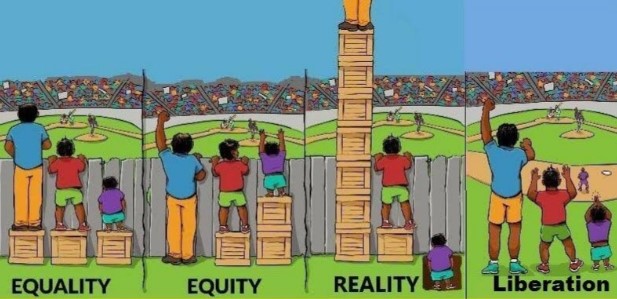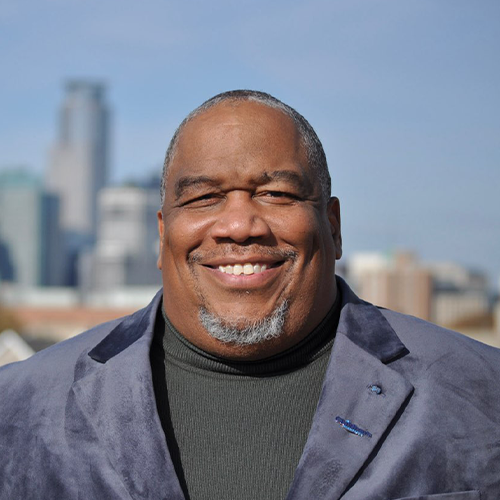Equality explained
As you can see on the left side of the image, equality is reflected by each kid having the same size box to stand on to watch the game. But the kids are of different heights, so although each kid has an “equal” box, they can’t all see the game.
- The shortest kid can’t see over the fence at all.
- The medium-height kid can barely see over it.
- The tall kid can easily see over it. He doesn’t need a box, yet he still has one.
Equality – each person having the same size box – doesn’t seem to work for everyone.
Equity explained
The visual for equity shows the boxes have been moved to accommodate each kid’s height. No new boxes (resources) were added.
- The shortest kid now has two boxes and is able to see over the fence.
- The medium size kid still has one box and is still able to see over the fence.
- The tallest kid no longer has a box. He didn’t need one to see the game, so his box is now being used by the shortest kid. Again, no new boxes were added. Instead, a box was moved.
Now that everyone can see over the fence, equity has been achieved. Or has it?
Sharing boxes
Many people describe the journey from equality to equity as NOT being a zero-sum game, meaning people who’ve always had access and opportunity won’t lose anything when everybody else gains access and opportunity. In other words, my share of the pie won’t get smaller when you start getting a share of the pie. Let’s examine if that’s true in the context of the baseball image.
For the short kid to have enough boxes to see the game, someone had to give up a box. If the medium kid gave up a box, he’d no longer be able to see the game. If the tall kid gives up a box, which he did, he can still see the game. And you’d expect that the tall kid is ok with giving away his box since it doesn’t affect his view. Or maybe not.
Let’s move to the picture titled “Reality.” It reflects our society’s present circumstances. The tall kid has many boxes, more than he needs. He represents people who have traditionally benefited from our systems of education, health, economic development, housing, wealth and well-being. The tall kid’s family has always had high wages, great jobs, generational wealth, protection from law enforcement and access to high-quality housing, food, education and services. The tall kid’s family has had many boxes for centuries and yet the families of the tall kids have never freely given up their boxes for the good of others.
To achieve equity, the tall kid will need to share some of the many boxes he’s standing on and doesn’t need. But what happens when you remove those boxes? The tall kid’s family will likely be unhappy, distraught, disappointed and maybe angry. They’ve had those boxes for centuries and may not want to disrupt the system (systemic racism) to achieve equity. They may say publicly that equity, diversity and inclusion are OK, but behind closed doors, their actions may indicate the opposite. They may privately say or think:
- Are the short kids qualified to receive my box?
- Are the short kids only being given my box because of their height? Isn’t that reverse box discrimination?
- Why are we focused on just these short kids? Aren’t there other kids who need my boxes too? What about them?
- I think it’s illegal to only use height to assign boxes.
Useful boxes
The illusion of equity is sometimes reflected in the visual of having the boxes removed from the tall kid and given to the short kid. We look at the result and appreciate the opportunity the short kid has to view the game. But it’s important to go further by asking:
- What’s in those boxes and are they usable?
- Are the boxes designed for the success of short kids or were they made specifically for tall kids?
Think about the last time you used boxes to move. Some boxes are new and crisp and can hold lots of weight. They won’t break easily and will keep your items safe. On the flip side, some moving boxes have been used too many times to be useful. They may be wet, worn or torn.
What if the tall kid gives weak boxes to the short kid? The tall kid could give a box named “mentoring and sponsorship” to the short kid without telling him that none of the mentors or sponsors in the box look like the short kid and some have never mentored a short kid. In fact, they’re not comfortable with short kids at all because they didn’t grow up around any. Is this box still useful?
The boxes must be examined carefully to determine if the short kid can use them. The boxes may not have been built with the short kid in mind. In fact, the boxes may have been built to oppress short kids. Expecting the small kid to use those boxes for equitable success would be ironic – and detrimental.
The fence is down – is equity achieved?
The last picture above, called “Liberation,” shows a baseball game without a fence, so no matter their height, all the kids can see the game without needing boxes. Does removing the fence mean true equity? I say probably not. There are still things we have to consider:
- Is the game the kids are watching a game they all want to see?
- is it a game that still oppresses short and medium size kids and benefits only tall kids?
- Would a different game be more beneficial to all kids?
Equity only exists when the fence is down and the racism and white supremacy in our system is dismantled. When this happens all kids, no matter their height, get to design a game that includes and values everyone.
Complex boxes
As you can see, there’s a lot to think about when it comes to equity. Superficial actions aren’t helpful. They can be harmful. The journey towards equity, diversity and inclusion is paved with opportunities to fail. So we need to think carefully and deeply about what will make a positive difference. We at Children’s Minnesota don’t have all the answers. That’s why we work closely with people in our community to identify where and how we can help in the best way possible.
If equity and inclusion were easy to achieve, we wouldn’t be in the position we’re in today. Moving, replacing or destroying boxes will make many people uncomfortable. It won’t be a zero-sum game. But when we’re successful, we’ll have a community, a country, where all kids have the opportunity to thrive.
And that will be worth it.


